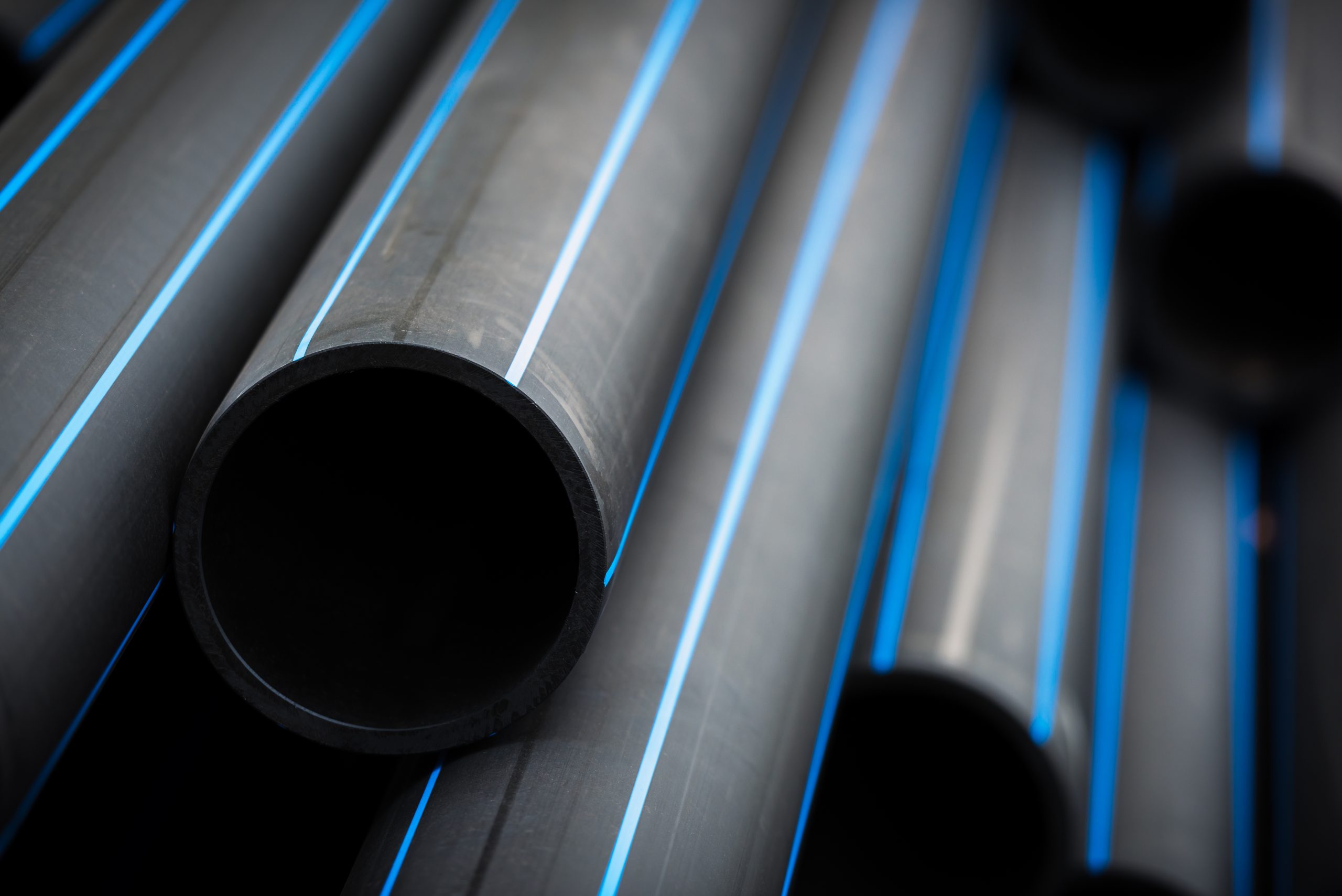HDPE Pipe For Water Supply
HDPE Pipes are one of the two largest thermoplastic pipelines available and by far the most versatile. Polyethylene is a wax like thermoplastic with a density varying from a range of 934 Kg/m3 to 960 Kg/m3 which is less than that of water. The only two additives that are added to polyethylene are Carbon black with a limit of 2-3% to add some reinforcing effect to increase its weathering properties and some Anti-Oxidant to a limit of 0.3%. HDPE having comparatively high molecular weight is high in abrasion resistance and impact strength. It is also very good in stress cracking resistance and has low creep rupture properties. It is excellent in insulation properties over a wide range of frequencies and good chemical properties.
Features & Benefits of HDPE Pipes
- Very low frictional resistance to fluid flow and thus saves energy cost for pumping.
- UV resistant Low wear and tear and fully abrasion resistant. Remains free from incrustation throughout the life span giving better flow always.
- Suitable to withstand high fluid flow and external soil pressure. Chemically inert and hence resistant to most chemicals and hostile corrosive soils.
- Excellent impact resistance, withstands water hammer shocks and transverse loads due to thermal stresses. Bending radius is 25 times the pipe diameter. Excellent elastic properties ensure absorption of soil movements, stresses and Hydraulic pressure.
- HDPE pipes are easier to handle & install compared to heavier metallic or concrete pipes. HDPE is about one-eight, the density of steel and thus does not require the use of heavy lifting equipment for installation.
- CPE HDPE is BIS certified & manufactured in compliance with the relevant Indian standard IS 4984
- Light weight facilitates easy handling and instant fixing. Joints obtained by Butt welding are homogenous and 100 % leak proof. Offers life of minimum 50 years.
- Available in single coil in lengths as required particularly the smaller diameter pipes. No additional joints, sockets, etc. are required.
- Ease of use with relining techniques avoiding opening of trenches, Outstanding ability to withstand Rapid Crack Propagation (RCP).
- Full joint traceability, ideal for renovation work through pipe bursting techniques, No requirements for protective coatings.


HDPE Pipes – Transportation of Potable Water as per IS 4984:2016, ISO 4427-1:2007:
- HDPE Pipes all over the world are widely used for conveyance of potable water, HDPE Pipes are non-toxic and do not impart any foul taste or smell to the water that is conveyed through it. They do not pose any damage through disinfectant also.
HDPE Pipes – Drainage & Sewerage Disposal as per IS 14333:1996:
- HDPE pipe for transportation of sewerage and industrial effluents are made as per IS: 14333:1996. The main advantages of HDPE pipes for conveyance of Sewerage and Industrial Effluents are.
- Resistance to chemical.
- Abrasion resistant.
- Resistant to treated or untreated water.
- Better mechanical properties including toughness.
- Greater burst strength due to flexibility.
- Excellent free flowing characteristics due to smoother inner surface.
- Higher longevity.
Applications
Environmental Protection:
- Underground drainage and sewerage application/rehabilitation of existing sewer.
- Effluent and waste treatment plants.
- Dust suppression piping systems in cement industry.
- Sand slurry disposal pipes in dredging.
- De-gassing pipes in water effluent marine outfalls.
cultural Systems:
- Column piping for Submersible and Jet Pumps.
- Suction and delivery pipes.
- Sprinkler and Drip Irrigation systems.
- Lift irrigation.
- Insecticide spraying.
Water Supply Systems:
- Transportation and Distribution system.
- House service connection.
- Rural, Municipal Water bodies, SEZ’s, Layout’s, etc
Industrial/Mining Systems:
- Effluents, chemicals and treated/untreated water disposal
- Hydro transport system for handling and conveyance of Iron, Coal and Cement slurry in mines.
- For conveyance of edible oil, fruit pulps, juices, milks and other food materials.
- As a ventilation and air conditioning duct.
Under Ground Cable Protection:
- Encasing of underground cable protection through Trenchless systems.
- Encasing of underground cable protection through Manual digging systems.
- Uses by all private sector, Construction & plastic Sector enterprises.
Available Size
| Grade | Nominal OD (mm) | Nominal Pressure (PN) |
|---|---|---|
| PE 63 | 40 mm to 250 mm | PN 2- PN 10 |
| PE 80 | 40 mm to 250 mm | PN 2- PN 10 |
| PE 100 | 40 mm to 250 mm | PN 2- PN 10 |
Features
- Economical than traditional pipe material.
- Resistance to chemicals- Exceptional resistance to all external and internal corrosion.
- Resistant to electrolytic corrosion.
- Will not rust or rot.
- Very good thermal insulation due to low thermal conductivity.
- Perfect stability of material obviates the risk of ageing.
- Total neutrality to products conveyed.
- Low maintenance cost.
- Easy to install.
- Longer life than G.I, M.S cement and other pipes.
- Economical than traditional pipe material.
- Resistance to chemicals- Exceptional resistance to all external and internal corrosion.
- Resistant to electrolytic corrosion.
- Will not rust or rot.
- Very good thermal insulation due to low thermal conductivity.
Recommendations
| SR No | PROPERTIES | VALUE |
| 1 | M.F.I. (190°C, 5kg load) | 0.20 to 1.1 gm/10 mins |
| 2 | Specified base density | 940 to 958 kg/mtr3 |
| 3 | Material Grade | PE-63, PE-80, PE-100 |
| 4 | Carbon Black | (2.5 ± 0.5%) |
| 5 | Antioxidant | <0.3% by mass |
| 6 | Tensile Strength (min) (27±2°C) | 19MPa |
| 7 | Elongation | (Testing speed = 100mm/min ± 10% ) >350% |
| 8 | Reversion | <=3% |
| 9 | Hydraulic Characteristics | No sign of localized swelling, leakage or weeping (at 80°C for 165 & 48 hrs.) |
